Integration of single-cell RNA sequencing and bulk RNA transcriptome sequencing reveals a heterogeneous immune landscape and pivotal cell subpopulations associated with colorectal cancer prognosis
- PMID: 37675100
- PMCID: PMC10477986
- DOI: 10.3389/fimmu.2023.1184167
Integration of single-cell RNA sequencing and bulk RNA transcriptome sequencing reveals a heterogeneous immune landscape and pivotal cell subpopulations associated with colorectal cancer prognosis
Abstract
Introduction: Colorectal cancer (CRC) is a highly heterogeneous cancer. The molecular and cellular characteristics differ between the colon and rectal cancer type due to the differences in their anatomical location and pathological properties. With the advent of single-cell sequencing, it has become possible to analyze inter- and intra-tumoral tissue heterogeneities.
Methods: A comprehensive CRC immune atlas, comprising 62,398 immune cells, was re-structured into 33 immune cell clusters at the single-cell level. Further, the immune cell lineage heterogeneity of colon, rectal, and paracancerous tissues was explored. Simultaneously, we characterized the TAM phenotypes and analyzed the transcriptomic factor regulatory network of each macrophage subset using SCENIC. In addition, monocle2 was used to elucidate the B cell developmental trajectory. The crosstalk between immune cells was explored using CellChat and the patterns of incoming and outgoing signals within the overall immune cell population were identified. Afterwards, the bulk RNA-sequencing data from The Cancer Genome Atlas (TCGA) were combined and the relative infiltration abundance of the identified subpopulations was analyzed using CIBERSORT. Moreover, cell composition patterns could be classified into five tumor microenvironment (TME) subtypes by employing a consistent non-negative matrix algorithm. Finally, the co-expression and interaction between SPP1+TAMs and Treg cells in the tumor microenvironment were analyzed by multiplex immunohistochemistry.
Results: In the T cell lineage, we found that CXCL13+T cells were more widely distributed in colorectal cancer tissues, and the proportion of infiltration was increased. In addition, Th17 was found accounted for the highest proportion in CD39+CD101+PD1+T cells. Mover, Ma1-SPP1 showed the characteristics of M2 phenotypes and displayed an increased proportion in tumor tissues, which may promote angiogenesis. Plasma cells (PCs) displayed a significantly heterogeneous distribution in tumor as well as normal tissues. Specifically, the IgA+ PC population could be shown to be decreased in colorectal tumor tissues whereas the IgG+ PC one was enriched. In addition, information flow mediated by SPP1 and CD44, regulate signaling pathways of tumor progression. Among the five TME subtypes, the TME-1 subtype displayed a markedly reduced proportion of T-cell infiltration with the highest proportion of macrophages which was correlated to the worst prognosis. Finally, the co-expression and interaction between SPP1+TAMs and Treg cells were observed in the CD44 enriched region.
Discussion: The heterogeneity distribution and phenotype of immune cells were analyzed in colon cancer and rectal cancer at the single-cell level. Further, the prognostic role of major tumor-infiltrating lymphocytes and TME subtypes in CRC was evaluated by integrating bulk RNA. These findings provide novel insight into the immunotherapy of CRC.
Keywords: Treg; colorectal cancer; immune landscape; plasma B cell; single cell; tumor-associated macrophages.
Copyright © 2023 Zhang, Liu, Wang, Zhang, Hou and Liu.
Conflict of interest statement
The authors declare that the research was conducted in the absence of any commercial or financial relationships that could be construed as a potential conflict of interest.
Figures

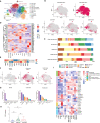
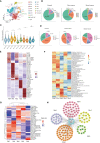

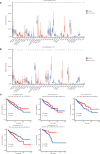

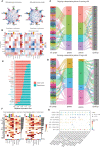
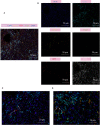
Similar articles
-
Integrating single-cell and bulk RNA sequencing reveals CK19 + cancer stem cells and their specific SPP1 + tumor-associated macrophage niche in HBV-related hepatocellular carcinoma.Hepatol Int. 2024 Feb;18(1):73-90. doi: 10.1007/s12072-023-10615-9. Epub 2023 Dec 30. Hepatol Int. 2024. PMID: 38159218
-
ANGPTL2+cancer-associated fibroblasts and SPP1+macrophages are metastasis accelerators of colorectal cancer.Front Immunol. 2023 Aug 24;14:1185208. doi: 10.3389/fimmu.2023.1185208. eCollection 2023. Front Immunol. 2023. PMID: 37691929 Free PMC article.
-
Single-Cell RNA Sequencing Reveals the Heterogeneity of Tumor-Associated Macrophage in Non-Small Cell Lung Cancer and Differences Between Sexes.Front Immunol. 2021 Nov 5;12:756722. doi: 10.3389/fimmu.2021.756722. eCollection 2021. Front Immunol. 2021. PMID: 34804043 Free PMC article.
-
Colorectal Cancer-Infiltrating Regulatory T Cells: Functional Heterogeneity, Metabolic Adaptation, and Therapeutic Targeting.Front Immunol. 2022 Jul 8;13:903564. doi: 10.3389/fimmu.2022.903564. eCollection 2022. Front Immunol. 2022. PMID: 35874729 Free PMC article. Review.
-
Redefining Tumor-Associated Macrophage Subpopulations and Functions in the Tumor Microenvironment.Front Immunol. 2020 Aug 4;11:1731. doi: 10.3389/fimmu.2020.01731. eCollection 2020. Front Immunol. 2020. PMID: 32849616 Free PMC article. Review.
Cited by
-
Neutrophil extracellular trap related risk score exhibits crucial prognostic value in skin cutaneous melanoma, associating with distinct immune characteristics.Skin Res Technol. 2024 Aug;30(8):e70008. doi: 10.1111/srt.70008. Skin Res Technol. 2024. PMID: 39167030 Free PMC article.
-
TP63 transcriptionally regulates SLC7A5 to suppress ferroptosis in head and neck squamous cell carcinoma.Front Immunol. 2024 Aug 21;15:1445472. doi: 10.3389/fimmu.2024.1445472. eCollection 2024. Front Immunol. 2024. PMID: 39234254 Free PMC article.
-
Elucidating the role of angiogenesis-related genes in colorectal cancer: a multi-omics analysis.Front Oncol. 2024 Jun 19;14:1413273. doi: 10.3389/fonc.2024.1413273. eCollection 2024. Front Oncol. 2024. PMID: 38962272 Free PMC article.
-
Multi-omics insights of immune cells in the risk and prognosis of idiopathic membranous nephropathy.Commun Biol. 2025 Aug 10;8(1):1192. doi: 10.1038/s42003-025-08642-3. Commun Biol. 2025. PMID: 40783650 Free PMC article.
-
The immune duality of osteopontin and its therapeutic implications for kidney transplantation.Front Immunol. 2025 Feb 28;16:1520777. doi: 10.3389/fimmu.2025.1520777. eCollection 2025. Front Immunol. 2025. PMID: 40093009 Free PMC article. Review.
References
Publication types
MeSH terms
LinkOut - more resources
Full Text Sources
Medical
Research Materials
Miscellaneous

